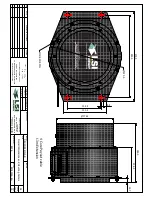
Data Logging on RCI Systems
The first two Function codes in the t able are used for determination of a stable load.
When a load is hoisted it is probable that the initial load reading will be greater than
the actual lo ad on th e hook because of the "snatching effect". The stable load is
recorded only when these dynamic facto rs have died down and th e load can be
considered to be hanging from the hook in a relatively motion free position.
The "Stable load tim e" a nd "S table load va riation" Function codes can be used to
adjust the load reco rding to minimise the effect of dynamic factors. The load will be
considered stable if the load reading doe s not change by m ore than the "Stable load
variation" setting (which is 0.1t by default) for a period of tim e set by "Stable load
time" (which is 2 seconds by default).
The third F unction code, "Reset time," is used for terminating a lif t. When the load
causes a SWL % which is less than the logging values (specifically the Low Load Lift
counter percentage), then it is assumed that the driver m ust be putting the load down
again. In orde r to ensure that a single lo ad is not logged multiple times because the
SWL % was hovering around the logging threshold, a log cycle will not com plete
until the load S WL % rem ains below the threshold for a certain period of tim e,
namely of course the "Reset time" (by default the reset time is set for 5 seconds).
Log Cycle Description
Two types of log cycles are possible:
1. Load is lifted inside load chart boundaries (valid SWL is seen at all times).
2. SWL drops to 0 indicating the load ch art has been exce eded, sensor e rror has
occurred or slew error has occurred.
Type 1 Log- Valid SWL cycle
A log cycle is started when:
•
the current SWL % (load/swl) exceeds the THRESHOLD (which will be the value
set for the Low Load Lift Counter function Code).
During a log cycle:
•
the load is monitored, the pe ak load seen is co ntinually updated and if n o stable
load has been recorded then all other data is recorded against peak load.
•
a stable load condition w ill apply when the load remains within a small variation
range (set by user through F-Code "Stable Load Variation") for a certain period of
time (also an F-Code "Stable Load Time").
•
when a stable load is seen, a ll data (e xcept peak load) are recorded against the
stable load.
Содержание RCI-1502 HRT
Страница 2: ......
Страница 4: ......
Страница 6: ......
Страница 8: ......
Страница 14: ......
Страница 22: ......
Страница 44: ......
Страница 52: ......
Страница 56: ......
Страница 58: ......
Страница 59: ...Appendix 8 1 Data Logging on RCI Systems ...
Страница 60: ......
Страница 66: ...Data Logging on RCI Systems Example Lift Cycles ...
Страница 71: ...Appendix 8 2 Drawings ...
Страница 72: ......
Страница 73: ......
Страница 74: ......
Страница 76: ......
Страница 77: ...APPROVED BY TOL 0 0 0 1 2 3 4 55 26 2 0 7 2 8 9 1 1 1 1 0 7 5 6 2 ...
Страница 79: ...APPROVED BY TOL 0 0 0 1 22 3 4 5 6 0 22 2 1 7 8 98 1 7 8 98 7 8 98 7 8 98 1 0 9 8 3 6 8 3 ...
Страница 80: ... APPROVED BY 0 1 2 22 3 3 3 TOL 4 4 23 4 232 22 3 242 4 2 32 2 3516 7 8 7 7 9 2 3 42 4 2 ...
Страница 81: ... APPROVED BY 0 1 2 22 3 3 3 TOL 4 4 23 4 232 22 5 0 42 4 2 3617 8 9 8 8 2 ...
Страница 82: ......
Страница 83: ......
Страница 87: ......
Страница 88: ......
Страница 89: ......
Страница 90: ......
Страница 91: ......
Страница 92: ......
Страница 93: ......
Страница 94: ......
Страница 95: ......
Страница 96: ......
Страница 97: ......
Страница 98: ......
Страница 99: ......
Страница 100: ......
Страница 101: ......
Страница 103: ......
Страница 104: ......
Страница 105: ......
Страница 106: ......
Страница 107: ......
Страница 108: ......
Страница 109: ......
















































